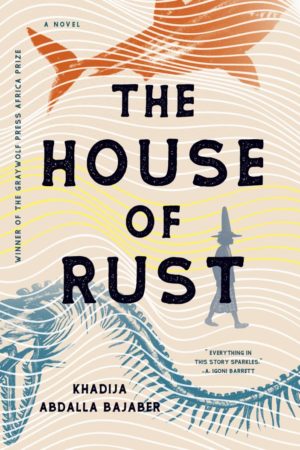You have no items in your cart. Want to get some nice things?
Go shopping
The protagonist of Khadija Agdalla Bajaber’s The House of Rust seeks to own her name – Aisha, which means life – to wrestle it from both her enemies and her allies because “names had power, even hers, and they could be used.” Called girl, child, or the endearing fishling by the adults in her life and viewed as a “monster girl weirdo” by the spying crows who watch her, Aisha has a fight on her hands. Haunted by thoughts of her mother, Shida (meaning trouble and indicating her illegitimate birth), who was unwillingly bound to a domestic life and died young, Aisha struggles to untangle herself from the obligations of being a woman in a Hadrami community in the coastal city of Mombasa, Kenya. Convinced that her rightful place is at sea but unsure, believing her weakness to outweigh her courage, Ayesha is ripe for an adventure. When her father Ali, a talented but wayward fisherman, disappears at sea, Aisha sets out to find him. She has five days before he is declared dead by her grandmother and funeral rites are held. In a boat made of bones, she undertakes a feminist anti-quest, driven by a rage that “rippled through her veins” and guided by Hamza, a talking cat, whose transformation from stray to wise protector tips the narrative from magical realism into the realm of legend.
The novel stakes its claim as ocean literature by combining the perilous purpose exemplified by Moby Dick with the fantastical interspecies exploits that readers might be familiar with from Yann Martel’s Life of Pi. It also has elements in common with coastal stories from African and elsewhere in which lives are governed by a sea that itself becomes a character; generous and capricious, alternately swallowing, battering, sniffling and murmuring as the characters negotiate its dangers. From the bloodied maws of the three increasingly terrifying sea monsters that Aisha encounters to disembodied flesh-eating eyes, the prehistoric horrors of this ocean world stretch imaginative limits. The narrative is lush and lyrical – “Sharks rising like foam as Aisha choked on her kicking heart” – with wave after wave of visceral imagery forcing the reader to cling on with Aisha as she chases her father’s fate, knowing that it will decide her own. Asked by the Sunken King, the second of the monsters, “‘What historian follows a fisherman?’” Aisha replies, “‘One in love with story-craft.’” She is weaving her own origin story to rival his gruesome one in which, he explains, man has long been at war with the sea: “I adorned myself with your dead, I wear their skins and eat their drowned.” Aisha shows herself to be a new kind of sailor, wild and wary but poised to learn painful lessons.
The House of Rust reminds us that the revolutionary power of fabulist stories is that they are so close to reality it hurts. Aisha’s fragile skeleton boat is repeatedly drenched in blood, the liquid of life but also the drying rust of death, connecting human and animal in a huge ecological drama. As Zubeir, shark hunter, “heart-cutter,” and Aisha’s second guide, explains the secrets of love and the heart, she vacillates between incomprehension, repeating, “I do not understand,” and a flinty determination to find out exactly how far, and how deep, she can go, literally and metaphorically.
Aisha is an anti-heroine in an era of climate crisis when the danger of and to the human has risen to the surface. Her vulnerability – as is often the case with child characters – enables her to see past the stock characterisations of other creatures and to reveal both their strangeness and their power. Most notably, sharks play an important role in the novel. Initially, they are instinct-driven eating machines operating en masse at the violent command of Baba Wa Papa, the father of sharks. But under Aisha’s influence they become a smoothly operating army of liberation, a “retinue of devourers” bearing her forward against her foe. The shark as a creature assumed to be fearsome but essential to marine ecology becomes a metaphor both for the need to interrogate ordinary beliefs (in which Aisha as a girl in a traditional society is trapped) and for the complexity of planetary relationships in which every creature plays a role. Repeatedly Aisha is told by her guides, “Pay attention, Aisha. Everyone must have their share.”
The novel critiques dull-eyed human life through Aisha’s interactions with animals, from goats to rats. The political manoeuvring of a city that cannot stand “the pompous” is scrutinised via another mistrusted creature, the crow. When Aisha returns to Mombasa, a rebel crow standing up against the birds’ tyrannical leader known as The Burned One, becomes her “shadow.” Following the “eerie” girl’s perambulations around the city as she seeks the mysterious House of Rust that Hamza has promised her makes him a witness to delusions of power, adorned with the spoils of empire. Mombasa itself takes shape in a briney rain-swept atmosphere of competition in which knowledge is both a treasure and a mortal danger. It is the scene of “an old game” that Aisha must play.
“I don’t need you to believe in the story,” Aisha tells her grandmother. “I just need you to believe in me.” In a world of magic and trickery, this is no simple demand and it involves reckoning with the past. At the beginning of the novel we learn that “for Aisha, in her mother’s name hung rainstorms and rust. Ungalvanised, galvanizing, sharp.” Through her quest, this odd heroine sweetens the sharpness as an ingredient in her own story, discovering that there are “songs about girls like me” and they are full-bodied and worth pursuing. A debut novel that won the inaugural Graywolf Press Africa Prize, The House of Rust is a masterful weaving of Hadrami storytelling into an unusual coming-of-age journey that demands the attention it is getting.
The House of Rust
By Khadija Abdalla Bajaber
Graywolf Press, 272 pages

About Veronica Barnsley
Veronica is an academic and writer who teaches English at the University of Sheffield. She's working on a book on representations of childhood in global literatures. Her recent fiction and essays can be found in Brittle Star, White Wall Review and Like the Wind.




